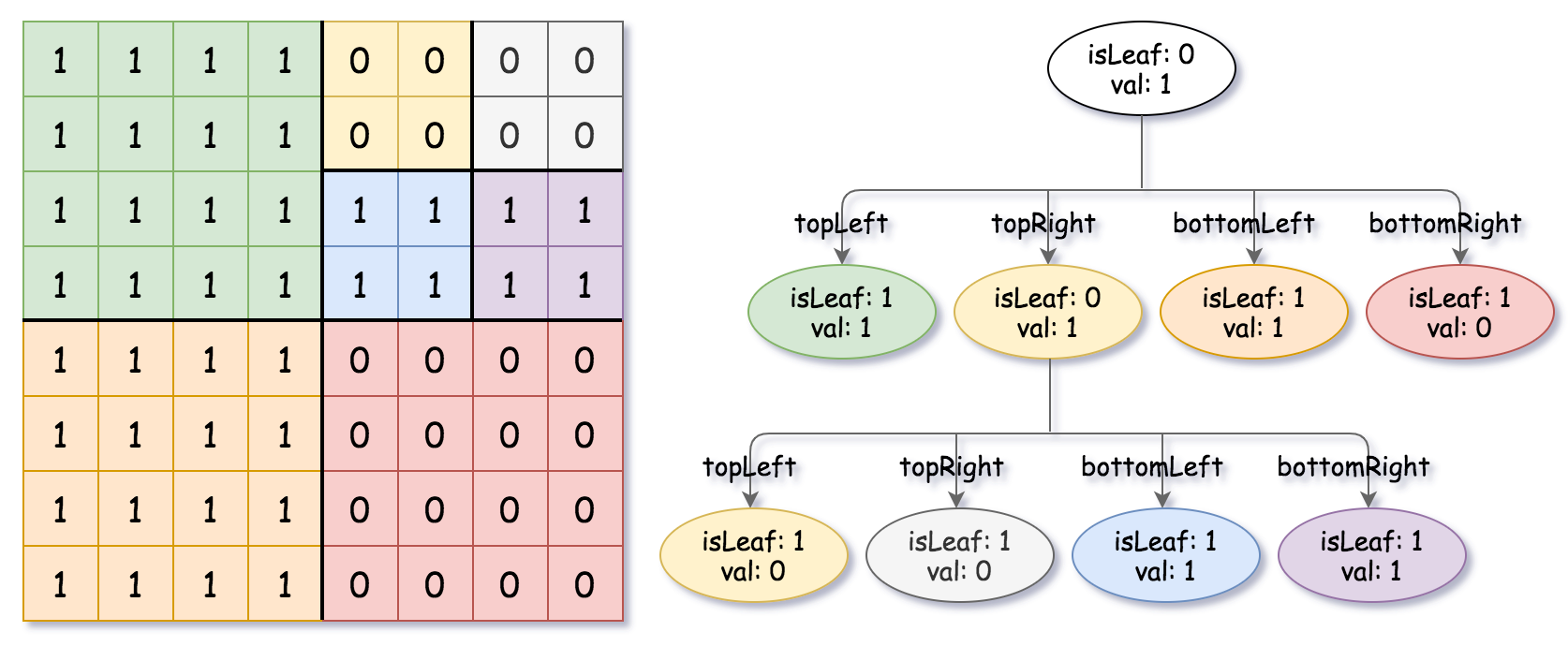LeetCode 427. Construct Quad Tree
原题链接在这里:https://leetcode.com/problems/construct-quad-tree/
题目:
Given a n * n matrix grid of 0's and 1's only. We want to represent the grid with a Quad-Tree.
Return the root of the Quad-Tree representing the grid.
Notice that you can assign the value of a node to True or False when isLeaf is False, and both are accepted in the answer.
A Quad-Tree is a tree data structure in which each internal node has exactly four children. Besides, each node has two attributes:
val: True if the node represents a grid of 1's or False if the node represents a grid of 0's.isLeaf: True if the node is leaf node on the tree or False if the node has the four children.
class Node {
public boolean val;
public boolean isLeaf;
public Node topLeft;
public Node topRight;
public Node bottomLeft;
public Node bottomRight;
}
We can construct a Quad-Tree from a two-dimensional area using the following steps:
- If the current grid has the same value (i.e all
1'sor all0's) setisLeafTrue and setvalto the value of the grid and set the four children to Null and stop. - If the current grid has different values, set
isLeafto False and setvalto any value and divide the current grid into four sub-grids as shown in the photo. - Recurse for each of the children with the proper sub-grid.

If you want to know more about the Quad-Tree, you can refer to the wiki.
Quad-Tree format:
The output represents the serialized format of a Quad-Tree using level order traversal, where null signifies a path terminator where no node exists below.
It is very similar to the serialization of the binary tree. The only difference is that the node is represented as a list [isLeaf, val].
If the value of isLeaf or val is True we represent it as 1 in the list [isLeaf, val] and if the value of isLeaf or val is False we represent it as 0.
Example 1:

Input: grid = [[0,1],[1,0]] Output: [[0,1],[1,0],[1,1],[1,1],[1,0]] Explanation: The explanation of this example is shown below: Notice that 0 represnts False and 1 represents True in the photo representing the Quad-Tree.

Example 2:

Input: grid = [[1,1,1,1,0,0,0,0],[1,1,1,1,0,0,0,0],[1,1,1,1,1,1,1,1],[1,1,1,1,1,1,1,1],[1,1,1,1,0,0,0,0],[1,1,1,1,0,0,0,0],[1,1,1,1,0,0,0,0],[1,1,1,1,0,0,0,0]] Output: [[0,1],[1,1],[0,1],[1,1],[1,0],null,null,null,null,[1,0],[1,0],[1,1],[1,1]] Explanation: All values in the grid are not the same. We divide the grid into four sub-grids. The topLeft, bottomLeft and bottomRight each has the same value. The topRight have different values so we divide it into 4 sub-grids where each has the same value. Explanation is shown in the photo below:

Constraints:
n == grid.length == grid[i].lengthn == 2xwhere0 <= x <= 6
题解:
When presenting the grid with quad tree.
If the grid has all identical val, then it could be a leaf. Its val is boolean value, when all vals are 1, then node val is 1. vice versa.
Split the grid into 4 parts, if all of them are leaves and all 4 parts value are identical then it is a leaf.
Time Complexity: O(n^2). n = grid.length. The DFS leves level takes n^2, one level up it takes n^2 / 4, one level up it takes n^2 / 64, the root level takes O(1). Add them up, the sum is smaller than n^2 * 2.
Space: O(logn). stack space.
AC Java:
1 /* 2 // Definition for a QuadTree node. 3 class Node { 4 public boolean val; 5 public boolean isLeaf; 6 public Node topLeft; 7 public Node topRight; 8 public Node bottomLeft; 9 public Node bottomRight; 10 11 12 public Node() { 13 this.val = false; 14 this.isLeaf = false; 15 this.topLeft = null; 16 this.topRight = null; 17 this.bottomLeft = null; 18 this.bottomRight = null; 19 } 20 21 public Node(boolean val, boolean isLeaf) { 22 this.val = val; 23 this.isLeaf = isLeaf; 24 this.topLeft = null; 25 this.topRight = null; 26 this.bottomLeft = null; 27 this.bottomRight = null; 28 } 29 30 public Node(boolean val, boolean isLeaf, Node topLeft, Node topRight, Node bottomLeft, Node bottomRight) { 31 this.val = val; 32 this.isLeaf = isLeaf; 33 this.topLeft = topLeft; 34 this.topRight = topRight; 35 this.bottomLeft = bottomLeft; 36 this.bottomRight = bottomRight; 37 } 38 }; 39 */ 40 41 class Solution { 42 public Node construct(int[][] grid) { 43 if(grid == null || grid.length == 0 || grid[0].length == 0){ 44 return null; 45 } 46 47 return dfs(grid, 0, 0, grid.length); 48 } 49 50 private Node dfs(int[][] grid, int x, int y, int len){ 51 if(len == 1){ 52 return new Node(grid[x][y] == 1, true); 53 } 54 55 Node root = new Node(); 56 Node tl = dfs(grid, x, y, len / 2); 57 Node tr = dfs(grid, x, y + len / 2, len / 2); 58 Node bl = dfs(grid, x + len / 2, y, len / 2); 59 Node br = dfs(grid, x + len / 2, y + len / 2, len / 2); 60 if(tl.isLeaf && tr.isLeaf && bl.isLeaf && br.isLeaf && tl.val == tr.val && tr.val == bl.val && bl.val == br.val){ 61 root.val = tl.val; 62 root.isLeaf = true; 63 }else{ 64 root.topLeft = tl; 65 root.topRight = tr; 66 root.bottomLeft = bl; 67 root.bottomRight = br; 68 } 69 70 return root; 71 } 72 }



【推荐】国内首个AI IDE,深度理解中文开发场景,立即下载体验Trae
【推荐】凌霞软件回馈社区,携手博客园推出1Panel与Halo联合会员
【推荐】轻量又高性能的 SSH 工具 IShell:AI 加持,快人一步